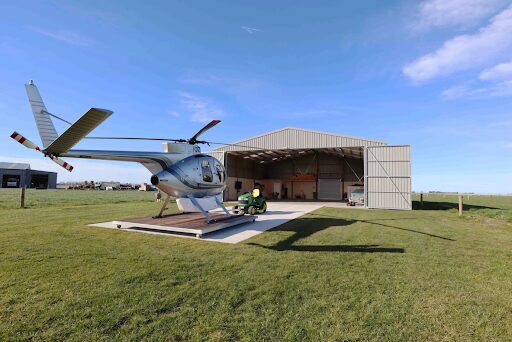Condensation can cause serious issues in aircraft hangars, from corrosion on your aircraft to mould on equipment – but it is preventable. To reduce condensation in your aircraft hangar, you need to manage moisture and temperature.
This means insulating the building and ventilating it properly so that warm, moist air doesn’t form water droplets on cold surfaces. In this guide, you’ll learn practical steps to keep your hangar dry and protect your aircraft from condensation damage.
Table of Contents
What Causes Condensation in Aircraft Hangars?
Condensation occurs when the outside temperature is colder than inside your shed, causing the air to reach its dew point. This results in the moisture content, or water vapour, turning into liquid droplets. In a hangar, this often happens when the metal roof or walls cool down at night and meet the humid air in the morning.
Steel structures heat and cool quickly, so a significant temperature difference between the indoor air and the metal cladding makes all-steel hangars particularly prone to condensation. As the moisture builds up, the building paper can no longer contain the quantity of liquid, and drips start to form.
Common contributors include:
- Poor ventilation: Inadequate airflow means humidity stays trapped inside, so moisture builds up on surfaces.
- High indoor humidity: Activities like washing aircraft, running engines, or storing damp materials can raise humidity indoors. Bringing a wet plane or equipment into the hangar can introduce lots of moisture as well.
- Ground moisture: Concrete slabs without an under-slab vapour barrier may allow water from the soil to seep up into the hangar, especially in wet climates or after rain.
Why is Condensation a Problem in Hangars?
Some common issues caused by excess condensation in an aircraft hangar include:
- Corrosion and rust: Metal aircraft parts and hangar steel beams can rust when continually exposed to moisture, compromising safety and requiring costly repairs.
- Mould and mildew: Damp conditions encourage mould growth on walls, upholstery, or stored items, damaging materials and posing health risks to staff.
- Insulation damage: If insulation soaks up water, it loses effectiveness. Wet insulation in a hangar will no longer keep temperatures stable and may harbour mildew.
- Equipment and electrical issues: Water can ruin electronics, avionics, and machinery. In severe cases, condensation can corrode wiring and electrical panels, creating safety hazards.
In addition, you might notice water dripping from the roof purlins or pooling on the floor, a slipping hazard and a sign that the moisture problem needs addressing.
How Can You Reduce Condensation in Your Aircraft Hangar?
Controlling condensation in a hangar comes down to keeping surfaces warm, letting moist air out, and keeping extra water out.
Here are some effective ways to achieve a drier, safer environment:
1. Consider a Timber Hangar Design
A hangar that utilises timber framing is the best way to reduce condensation in your hangar. Unlike steel structures, timber naturally helps regulate the temperature inside the hangar, which reduces internal temperature fluctuations – the primary cause of condensation.
This type of design is more effective and can be more affordable as little to no insulation is required, which can be costly and difficult to retrofit. If you’re looking to build, consider exploring aircraft hangar kits for sale that feature timber framing for better moisture control and long-term efficiency.
2. Ensure Proper Ventilation
Powered ventilation is also very effective. For example, exhaust fans or roof turbine vents (“whirlybirds”) can actively expel humid air, especially in high-moisture areas. Plan for cross-ventilation by having vents or windows on opposite walls to catch breezes.
In daily operation, you might open the big hangar doors on a dry, sunny day to air out humidity, but keep them closed during very damp weather to prevent bringing in more moisture.
3. Use Building Paper to Capture Moisture
One effective way to manage condensation is to use building paper on the roof and walls. This material helps capture moisture before it can form water droplets. By installing building paper, moisture is intercepted before it has a chance to build up and drip, preventing damage to aircraft and other equipment stored inside.
4. Control Indoor Humidity
Managing the humidity level inside the hangar will directly reduce the risk.
First, try to limit unnecessary moisture sources. For instance, avoid storing open water containers or wet materials inside. If you must wash the aircraft or floor indoors, do so sparingly and dry the area afterwards.
In extreme cases, using dehumidifiers can be a viable option. In a smaller hangar or enclosed workshop area, a portable electric dehumidifier can keep humidity in check.
Larger hangars might require commercial-grade dehumidifiers or multiple units. Additionally, maintaining a consistent moderate temperature helps. If the climate is cool and damp, a low-level heating system or climate control can prevent the interior air and surfaces from getting too cold overnight.
Finally, as noted above, keep the hangar closed during very humid or wet weather, to avoid inviting in damp air.
5. Use Smart Design Features
Small adjustments in the design can make a big difference in preventing condensation. If you’re planning to build a shed, here are three practical steps to consider:
- Add building paper to the roof: This material helps collect moisture buildup and reduces drips, preventing excess condensation from forming on the roof.
- Install a ply lining to the underside of the roof: Although adding ply lining increases the cost of the build, it will help to regulate internal temperature fluctuations which significantly reduces condensation .
- Add extra doors to your shed: The more doors you have, the better ventilation you’ll achieve. This allows more sun and wind to enter, helping air out the shed and reducing humidity.
Additionally, ensure the roof has an adequate slope to allow water to run off quickly, preventing pooling and prolonged dampness. You can also install gutters and downpipes to channel rain off the roof and away from the foundation, keeping the slab and surrounding soil dry.
It’s also a good idea to position your hangar on well-drained land and divert groundwater away from the structure.
6. Perform Regular Maintenance
Even a well-built, insulated hangar can develop moisture problems if components deteriorate. Here are some things you should include in your regular maintenance checklist:
- Look for any leaks in the roof and walls, as water leaks can mimic condensation issues.
- Repair damaged roof panels or sealant promptly and replace any sections of vapour barrier or insulation that have been compromised.
- Also, check that vents and fans remain clear of dust or obstructions, so they continue to function properly.
- During humid seasons, watch for signs of condensation like damp spots or a musty smell and act before it worsens.
A little proactive upkeep goes a long way in keeping your hangar’s protective features like insulation and ventilation systems working properly.
Final Thoughts
Condensation doesn’t have to be a constant concern in your aircraft hangar. With the right combination of insulation, ventilation, moisture barriers, and humidity control, you can create a stable environment that protects your aircraft, equipment and infrastructure year-round.
By applying the strategies outlined above and regularly maintaining your hangar, you’ll be better equipped to handle New Zealand’s varied climate.





